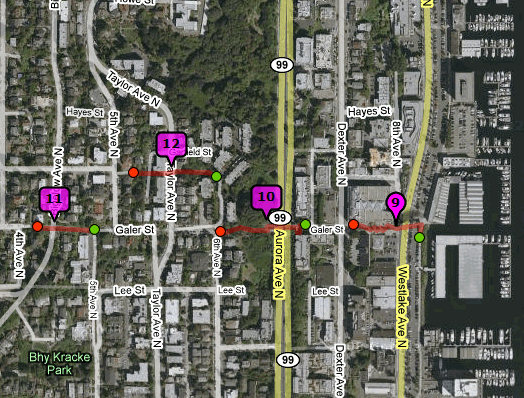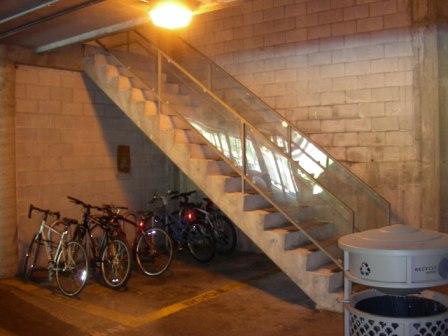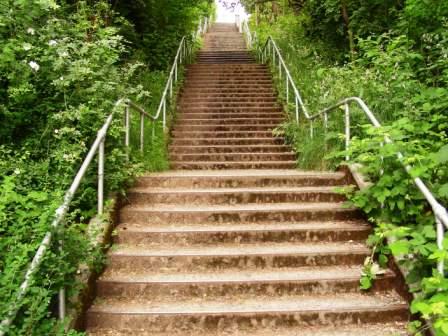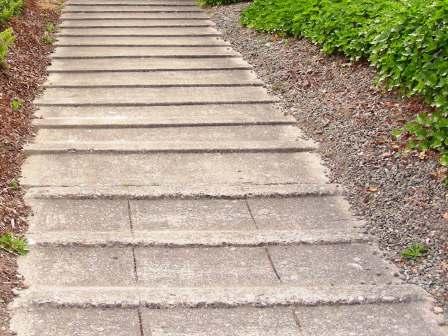 Beyerlein’s Rules for Counting Stairs
Beyerlein’s Rules for Counting Stairs  Beyerlein’s Rules for Counting Stairs
Beyerlein’s Rules for Counting Stairs |
1. Stairways start at the bottom and end at the top and must be continuous. Sounds simple. When they cross a street they still count as one stairway if they are not broken by a length of roadway along which one must travel to continue up the stairs. What sounded simple now sounds confusing, but it isn’t. For example, the Galer stairways on Queen Anne Hill in Seattle are not continuous. Between 6th Avenue North and 5th Avenue North is two blocks of Galer Street. One must run or walk on the sidewalk for these two blocks before encountering more stairs on the west side of 5th Ave N. I stopped counting stairs when I reached 6th and started over again at one when I reached the new Galer stairway at 5th. There is also at least one stairway where one must run down to run up (it is located in West Seattle, if you want to find it on your own). I counted the down stairs separately from the up stairs. At this West Seattle stairway neither the up nor the down stairway had 100 stairs separately, but combined they did. But by my rules this dual set of stairways did not make my list of major stairways that have at least 100 stairs (see Rule 7 below).
Only the stairs in one direction are counted when stairways have both down stairs and up stairs. For example, Middle Galer (#10) has some down stairs at the west end of the Aurora Avenue pedestrian bridge; these were not counted with the up stairs.
|

Galer Stairways: #9 Lower Galer, #10 Middle Galer, #11 Upper Galer, Seattle, WA
|
|
|
|
|
2. Curbs do not count as stairs. When stairs start at the bottom they start at the sidewalk, not the street. And when stairways cross streets the step down the curb and the step back up the other side are not counted. At least not by me.
|
|
|
|
|
|
3. All stairs are equal. Some have only an inch or two of rise (how high you have to step up). Others are very steep and have six inches or more of rise. For counting purposes they are equal.
|
|
|
|
|
|
4. Stairways must be available for public access. Stairways on private property are not counted unless they are signed as open to the public and are free (no access fee charged). Stairways on the University of Washington campus in Seattle are considered open to public access, as are the Pike Street Hillclimb stairs in downtown Seattle and the Grouse Grind on Grouse Mountain near North Vancouver, British Columbia, Canada.
|
 |
|
|
SW 19th Ave Stairway, Portland, OR
|
|
5. Stairways must be primarily outdoors. Stairways inside public or private buildings do not count. The Padelford Hall parking garage stairway on the University of Washington campus is considered primarily outdoors even though much of it is undercover because it is not climate controlled. A similar situation exists for the Pike Street Hillclimb stairway.
|
 |
|
|
Padelford Hall Stairway, University of Washington, Seattle, WA
|
|
6. Sidewalk bars are not counted as stairs. Some sidewalks on steep Seattle streets have slightly raised concrete bars across them. These bars give the pedestrian more traction going up or down the hill. These sidewalks and their bars are not stairways.
|
 |
 |
|
|
Stairs
|
Sidewalk Bars: Not Stairs
|
|
7. Major stairways must have 100 or more stairs. To be considered a major stairway and included on the list and map a stairway must have at least 100 continuous stairs. That is a totally arbitrary decision on my part, but it is a good way to separate the major stairways from the minor ones.
|
|
|
|
|